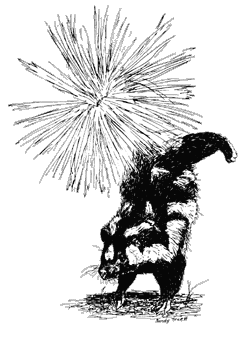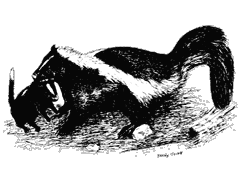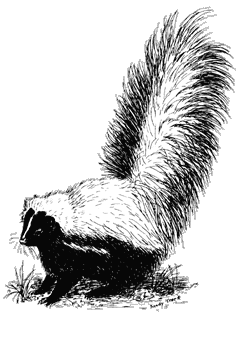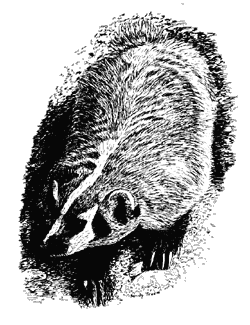Mustelids and Mephitids
The Mustelidae or weasel clan is a family known for its members’ fascinating habits; it includes the badgers, skunks, otters, ferrets and weasels. Although they have equally fascinating and similar habits to the mustelids, skunks are in a separate family: the Mephitidae. In the Sonoran Desert region only the badger and the skunks are common. Both badgers and skunks are nocturnal and have plantigrade hind feet (plantigrades walk flat-footed instead of on their toes like digitigrades), giving them a distinctive waddling, shuffling gait. Four-footed plantigrades are not fast runners, but badgers and skunks have other defenses.

Spotted skunk
The badger is renowned for its power, tenacity, and irascible temperament. Few animals care to tangle with an enraged badger. One badger even attacked a tractor that inadvertently ran over its den entrance! This animal is strictly a carnivore, well adapted to digging small mammals from the ground with its 1H inch long claws on powerful front feet. Its eyes are equipped with nictitating membranes (transparent third eyelids) to protect them from flying dirt while the badger is digging. Small, well-furred ears also keep dirt out while the badger tunnels. A badger is able to secrete a musky scent from its anal glands, but it can’t spray this fluid like skunks can.
The skunks, on the other hand, are rather phlegmatic animals. They seem to be aware that they have the most daunting weapon for almost any situation, and show great forbearance. Skunks give plenty of warning of their intent to spray, stamping their feet, and in the case of the spotted skunk, even doing a handstand before spraying. Skunks evidently find their own odor offensive; a skunk is reluctant to spray if restricted from getting its tail out of the way. Due to the great diversity of habitats in the Sonoran Desert, all four species of skunks are present here.
Sonoran Desert species:

Striped skunk
badger (Taxidea taxus)
spotted skunk (Spilogale gracilis)
striped skunk (Mephitis mephitis)
hooded skunk (Mephitis macroura)
hog-nosed skunk (Conepatus mesoleucus)
Order: Carnivora
Family: Mustelidae (badger); Mephitidae (skunk)
Spanish names: tejón (badger), zorrillo pinto
(spotted skunk), zorrillo listado (striped skunk)
Distinguishing Features
- Badger:
- The badger is a wide-bodied, short-legged creature of about 22 pounds. It has a distinctive white stripe running over its forehead and down its nose. Its coat is shaggy, with a yellowish brown color. Spotted Skunk: The spotted skunk is easy to identify. Smaller than the other skunks at about 2 pounds, its bold black and white pattern resembles spots instead of stripes. The tail is black at the base and white at the tip.
- Striped Skunk:
- There is variation in patterning among the skunks, but the striped usually has a black back with a white stripe along its sides. The tail is black with a white tip. The striped is a medium- to large-sized skunk at about 6 to 10 pounds (2.7-4.5 kg).
- Hooded Skunk:
- The hooded skunk looks much like the striped, but has a ruff of fur around the neck, and a very long, lush white plume for a tail.
- Hog-nosed Skunk:
- This is the least common skunk; it is all white on the top of head, back, and tail. The underparts are black. There is a bare patch of skin on this skunk’s long nose.
Habitat

Hooded skunk
Badgers inhabit the open, sandy flats with easily diggable soil, such as alluvial fans, creosote flats, farmland, grassland and even golf courses.
Skunks live in a variety of habitats from riparian canyons and wooded areas to Arizona uplands and suburbs. They prefer thick, brushy areas. The spotted skunk is most common in rocky, riparian canyons, while the hog-nose is usually found in the middle to higher elevations. None of the skunks are common in the low, dry flats.
Feeding
- Diet:
- Badgers are carnivores, eating gophers, ground squirrels, and many other rodents, snakes, lizards, birds, eggs, rabbits, and carrion. All the skunks are omnivores and opportunistic feeders. They eat anything from beetles, grubs, and grasshoppers to rodents, birds, carrion, seeds, and fruit.
- Behavior:
- Badgers dig, dig, and dig some more. They sniff out rodents or other prey and excavate them from their burrows faster than the little creatures can dig to escape. Skunks snuffle around or dig in the ground, turning over rocks, logs, and debris looking for insects, lizards, bird eggs, and so on. They hunt for mice and also search for fruit. The hog-nosed skunk uses its long snout to turn up leaf litter as it searches for worms, grubs, and insects.
Life History
Badger

Badger
Badgers are nocturnal carnivores that primarily dig in the ground for burrowing animals. They are armed with formidable claws on the front feet and ferocious temperaments. Few other animals will cross a badger (at least not more than once!). Badgers are solitary, and roam widely within their home ranges. They use different dens each day, choosing whatever happens to be handy after the night’s excavating. A badger sometimes makes a circuit, doubling back to check on holes it dug in the past to see if some tasty animal has moved in to take advantage of the leftover burrow.
Badgers mate in July and August, but due to delayed implantation, the badger kits are not born until February or March. Only the mother badger cares for the 2 to 5 babies. They stay with her for about 3 months; then they are on their own.
Skunks
Skunks are nocturnal creatures famous for their ability to spray a fluid so noxious that it can stop a predator in its tracks. The only major predator skunks have, aside from humans and automobiles, is the great horned owl, which has almost no sense of smell. Skunks usually have enough fluid for 5 or 6 volleys of spray, which they can shoot up to about 12 feet. Their bold black and white patterns, easily seen at night, function as aposematic (warning) coloring, advertising the skunks’ malodorous capabilities.
Skunks sometimes build their own dens, but often share the dens of other animals, particularly pack rats, or make use of other suitable sites such as brush piles, hollow logs, boulder piles, mine shafts, or underneath buildings. Their dens don’t smell like skunk spray, but do have a distinctive, strong, musky odor. Although they don’t hibernate, skunks gain extra weight in the fall, which tides them over the lean times during the winter. They retire underground for as many as several days at a time during cold winter storms.
The spotted skunk is the only one able to climb trees, which expands its foraging opportunities. This small skunk breeds in September and October, but delayed implantation results in the young being born in May. The other skunks all breed in the spring, with most babies born in May. The 3 to 7 kits stay with the mother through the summer, accompanying her on nocturnal hunting forays, before dispersing in the fall. Evidence of skunks in an area includes many divots in the earth and other signs of rooting, as well as scat containing berries, insect parts, and bits of fur.
River Otters
Although native river otters (Lutra canadensis sonorae) have been extirpated in Arizona, they may have been common in earlier times, especially in the Salt, Verde, and Gila rivers. Scientists aren’t certain exactly what caused their disappearance; there were likely a number of factors that combined to eradicate them, including diverted water and dammed rivers.
The Arizona Game and Fish Department released 46 transplanted Louisiana otters (Lutra canadensis leutra) into the Verde River between 1981 and 1983. The transplant proved very successful, with the population now estimated to be about 100 otters. Unfortunately, with the water tables continuously dropping in the Sonoran Desert, there are not very many other permanent streams suitable for otters.










